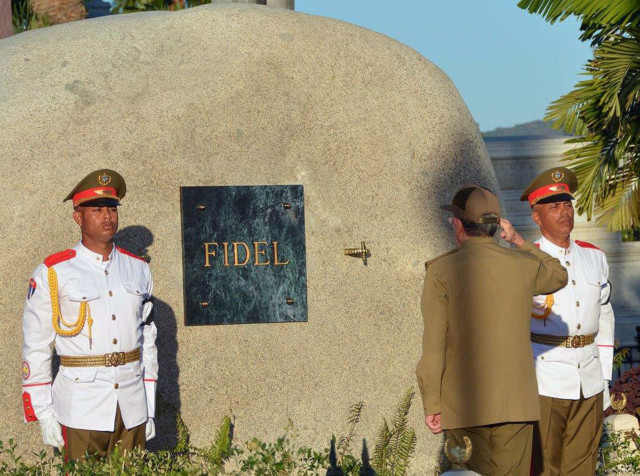Fidel Castro’s ashes were interred in a private ceremony Sunday morning, ending nine days of mourning for the man who ruled Cuba for nearly half a century.
CCTV America’s Michael Voss reports on the ceremony.

The military caravan bearing his remains in a flag-draped cedar coffin left the Plaza of the Revolution in the eastern city of Santiago at 6:39 a.m. Thousands of people lined the two-mile route to Santa Ifigenia cemetery, waving Cuban flags and shouting “Long live Fidel!”
Photographs taken by Cuban state media showed that the interment was presided over by Castro’s younger brother and successor, President Raul Castro, who wore his green military uniform as he placed the older man’s ashes into what appeared to be a niche in his tomb, a simple, grey, round stone about 15 feet high. The niche was then covered by a plaque bearing the single name, “Fidel.”
Those in attendance included Castro’s wife, Dalia Soto del Valle, other members of his family and presidents Nicolas Maduro of Venezuela and Daniel Ortega of Nicaragua, among others.
The gathering appeared to last about 90 minutes and took place entirely out of the public eye after Cuban officials made a last-minute cancellation of plans to broadcast the start of events live on national and international television. International media were barred from the event.
The tomb stood to the side of a memorial to the rebel soldiers killed in an attack that Castro led on Santiago’s Moncada barracks on July 26, 1953, and in front of the mausoleum of Cuban national hero Jose Marti.
Before the funeral ended, martial music could be heard outside the cemetery, where Ines de la Rosa was among the mourners gathered. She said she would have liked to watch the interment on television, but “we understand how they as a family also need a bit of privacy.”
Fellow mourner Elena Vinales said she wasn’t surprised that the images of the event were not broadcast. “It seems to be a family moment,” she said.
The decision to keep the final farewell private came the morning after Raul Castro announced that Cuba would prohibit the naming of streets and monuments after his brother, and bar the construction of statues of the former leader and revolutionary icon, in keeping with his desire to avoid a cult of personality.
“The leader of the revolution rejected any manifestation of a cult of personality and was consistent in that through the last hours of his life, insisting that, once dead, his name and likeness would never be used on institutions, streets, parks or other public sites, and that busts, statutes or other forms of tribute would never be erected,” Raul Castro told a massive crowd gathered in the eastern city of Santiago.
He said that Cuba’s National Assembly would vote in its next session on the law fulfilling the wishes of his brother, who died last week at 90. The legislature generally holds a meeting in December and under Cuba’s single-party system, parliament unanimously or near-unanimously approves every government proposal.
Fidel Castro, who stepped down in 2006 after falling ill, kept his name off public sites during his near half-century in power because he said he wanted to avoid the development of a personality cult. In contrast, the images of his fellow revolutionary fighters Camilo Cienfuegos and Ernesto “Che” Guevara became common across Cuba in the decades since their deaths.
Mourning for Castro has been fervent and intense across the country since his death, particularly in rural eastern Cuba, where huge crowds have been shouting Castro’s name and lining the roads to salute the funeral procession carrying his ashes.
“All of us would like to put Fidel’s name on everything but in the end, Fidel is all of Cuba,” said Juan Antonio Gonzalez, a 70-year-old retired economist. “It was a decision of Fidel’s, not Raul’s, and I think he has to be respected.”
Cubans find artistic inspiration following Castro’s passing
Many Cubans have taken the death of Fidel Castro very personally.
CCTV America’s Sean Callebs caught up with one resident of Santiago de Cuba, who has focused her grief on support for the former revolutionary.
Mabettis Suarez Cabrera makes a living performing traditional Cuban music around the town of Santiago. This week, she didn’t sing
Music and alcohol sales were halted, as the nation observed nine days of mourning.
Instead, Mabettis has turned her creative talents toward writing poems to honor the man called El Comandante.
Castro launched his revolution from the historic city of Santiago de Cuba. In the late 1950’s, he garnered international fame – as he led his rebels into power.
It is here, in Santiago-where Castro will be laid to rest next to Cuban hero Jose Marti, who fought for the country’s independence from Spain in the late 1800’s.

Fernando Menendez on the legacy of Fidel Castro
With Fidel Castro’s ashes reaching their destination and finally interred after nine days of mourning for Cuba, what will his legacy look like around the world? To discuss Castro’s funeral and more, CCTV America Susan Roberts spoke with Fernando Menedez, senior fellow for Strategic Initiatives for the Center for a Secure Free Society.
Story by the Associated Press
 CGTN America
CGTN America Cuba’s President Raul Castro salutes at the tomb of his older brother Fidel Castro, a simple, grey, round stone about 15 feet high, at the Santa Ifigenia cemetery in Santiago, Cuba, Sunday Dec.4, 2016. Raul Castro placed the ashes in a niche in the tomb that was then covered by a plaque bearing the single name,”Fidel.”(Marcelino Vazquez Hernandez/Pool Photo via AP)
Cuba’s President Raul Castro salutes at the tomb of his older brother Fidel Castro, a simple, grey, round stone about 15 feet high, at the Santa Ifigenia cemetery in Santiago, Cuba, Sunday Dec.4, 2016. Raul Castro placed the ashes in a niche in the tomb that was then covered by a plaque bearing the single name,”Fidel.”(Marcelino Vazquez Hernandez/Pool Photo via AP)
